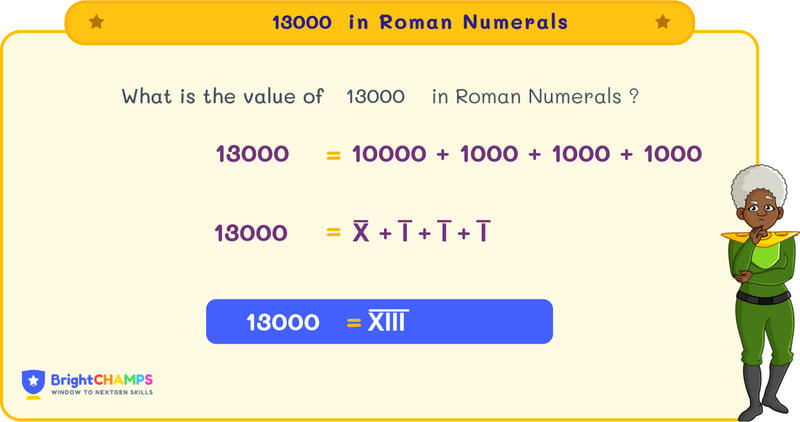
 229 Learners
229 LearnersLast updated on May 26th, 2025

13000 in Roman Numerals

Roman numerals are a way of expressing numbers using symbols like I, V, X, L, C, D, and M. Roman Numerals are used in royal titles, book names, sequences, and so on. Here we will be discussing Roman Numerals, rules, and examples.
What is 13000 in Roman Numerals?
Just like in royal titles such as Henry I, Henry II, and so on, Roman Numerals are prevalent. Have you ever wondered what these symbols (I and II) represented?
Those are the Roman Numerals. In earlier times, people used fingers, sticks, bones, etc., to count. As life became more complex, a standardized form was needed to count. Ancient Romans developed the Roman Numeral system to meet this need. The symbols I (1), V (5), X (10), L (50), C (100), D (500), and M (1000) are used in this system.
To represent 13000 in Roman Numerals, we use the symbol M for 1000 and write it thirteen times: MMMMMMMMMMMMM. Let’s learn more about Roman numerals and how we write them.

Basic Rules for 13000 in Roman Numerals
There are certain basic rules to write a number in Roman Numerals. In this section, let’s discuss some basic rules that need to be remembered when writing a number in Roman Numerals.
Rule 1: Addition Method
The addition method is used when the smaller number is placed after the larger number. For example, VI → V + I → 5 + 1 = 6
Rule 2: Repetition Method
To write large numbers, certain Roman Numerals can be repeated. For example, the numeral M can be repeated to represent large numbers like 3000 (MMM).
Rule 3: Subtraction Method
If a small number precedes a large number in Roman Numerals, we subtract the smaller number from the larger number. For example, IX → X - I → 10 - 1 = 9
Rule 4: Limitation Rule
Symbols cannot be repeated more than three times, and some symbols like V, L, and D cannot be repeated. For example, we won't write VV for 10; instead, we use X.
How to Write 13000 in Roman Numerals
Let’s now learn how to write 13000 in Roman Numerals. Follow these methods to write the number in Roman Numerals:
- By Expansion Method
- By Grouping Method
13000 in Roman Numeral by Expansion Method
In the expansion method, based on place value, the number is broken down. In this section, we will learn how to write 13000 in Roman Numerals using the expansion method.
To write 13000 in Roman Numerals, follow these steps:
Step 1: Break the number based on place value, such as ones, tens, hundreds, etc. For 13000, we write it as 10000 + 3000.
Step 2: Converting the number into Roman Numerals 10000 in Roman Numerals — X (10 times M, which is represented by a line over the X) 3000 in Roman Numerals — MMM
Step 3: Combining the Roman Numerals together.
Therefore, 13000 in Roman Numerals is X̅MMM
13000 in Roman Numeral by Grouping Method
When writing a large number in Roman Numerals, we group the number.
To write 13000 in Roman Numerals, we group 13000 as 10000 + 3000.
10000 in Roman Numerals — X̅
3000 in Roman Numerals — MMM
So, 13000 is written as X̅MMM in Roman Numerals.

Common Mistakes and How to Avoid Them in 13000 Roman Numerals
Students make mistakes when writing numbers in Roman Numerals. To master Roman Numerals, we can learn a few common mistakes and ways to avoid them.

13000 in Roman Numerals Examples

Problem 1
A historian found XIII ancient scrolls, each inscribed with the number M. What is the total number represented by all the scrolls in Roman numerals?

The total number represented by all the scrolls is XIII times M, which is XIII times 1000, or 13000, which is written as X̅I̅I̅I̅.
Explanation
In this scenario, XIII represents 13 and M represents 1000. Multiplying these two numbers gives us 13 × 1000 = 13000. In Roman numerals, 13000 is represented as X̅I̅I̅I̅.

Problem 2
A collector has M̅MMM coins, each valued at MCD. Calculate the total value of the coins in Roman numerals.

The total value of the coins is M̅MCMCD
Explanation
First, convert the Roman numerals to numbers:
M̅MMM = 3000
MCD = 1400
Calculate the total value: 3000 × 1400 = 4200000
Convert 4200000 into Roman numerals: 4200000 is represented as M̅MCMCD in Roman numerals.

Problem 3
A marathon has X̅III participating teams. Each team has M members. How many members are participating in total?

The total number of members participating is XIII times M, which is X̅I̅I̅I̅ times 1000, or 13000.
Explanation
In this scenario, X̅III represents 13, and M is 1000.
Therefore, the total number of members is 13 × 1000 = 13000.
In Roman numerals, 13000 is represented as X̅I̅I̅I̅.

Problem 4
A library receives a shipment of books totaling M̅MCCC. If the books are equally distributed among XIII branches, how many books does each branch receive?

Each branch receives M books.
Explanation
First, convert the Roman numerals to numbers:
M̅MCCC = 2300
XIII = 13
Divide the total number of books by the number of branches: 2300 ÷ 13 = 100
Convert 100 into Roman numerals: 100 is represented as C in Roman numerals, so each branch receives C books.

Problem 5
Calculate the Roman numeral representation for the sum of M̅C and M̅CCII.

The sum of M̅C and M̅CCII is M̅CCCII.
Explanation
First, convert the Roman numerals to numbers:
M̅C = 1100
M̅CCII = 1202
Calculate the sum: 1100 + 1202 = 2302
Convert 2302 into Roman numerals: 2302 is represented as M̅CCCII in Roman numerals.


FAQs on 13000 in Roman Numerals
1.What is 9000 in Roman numerals?
2.How to write 13000 in Roman numerals?
3.What is 16000 in Roman Numerals?
4.Is 13000 a prime number?
5.What are the multiples of 13000?
6.How can children in Qatar use numbers in everyday life to understand 13000 in Roman Numerals?
7.What are some fun ways kids in Qatar can practice 13000 in Roman Numerals with numbers?
8.What role do numbers and 13000 in Roman Numerals play in helping children in Qatar develop problem-solving skills?
9.How can families in Qatar create number-rich environments to improve 13000 in Roman Numerals skills?
Important Glossaries for 13000 in Roman Numerals
- Addition Rule: The addition method is used when a larger numeral is followed by a smaller numeral, here the values are added. For example, XVI = X + V + I = 10 + 5 + 1 = 16.
- Grouping Method: Numbers are grouped based on their place value and then converted into Roman Numerals. For example, 13000 = 10000 + 3000 = X̅MMM.
- Repetition Rule: Certain symbols (I, X, C, M) in the Roman numeric system can be repeated only up to three times. For example, III = 3 (I is repeated three times to represent the number 3).
- Subtraction Rule: A smaller numeral preceding a larger one means subtraction. For example, IV = V - I = 4.
- Expansion Method: Breaking down numbers by place value before converting to Roman Numerals. For example, 13000 is decomposed as 10000 + 3000.
Explore More numbers
![Important Math Links Icon]() Previous to 13000 in Roman Numerals
Previous to 13000 in Roman Numerals
![Important Math Links Icon]() Next to 13000 in Roman Numerals
Next to 13000 in Roman Numerals
About BrightChamps in Qatar


Hiralee Lalitkumar Makwana
About the Author
Hiralee Lalitkumar Makwana has almost two years of teaching experience. She is a number ninja as she loves numbers. Her interest in numbers can be seen in the way she cracks math puzzles and hidden patterns.
Fun Fact
: She loves to read number jokes and games.




